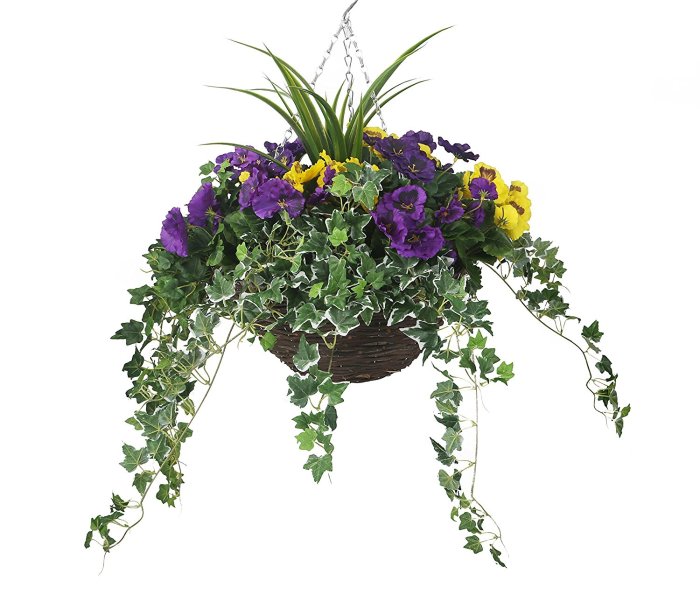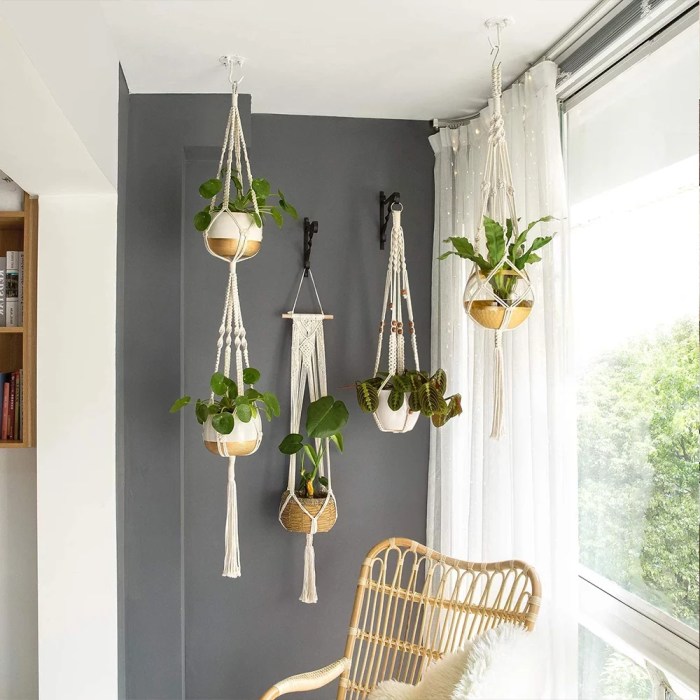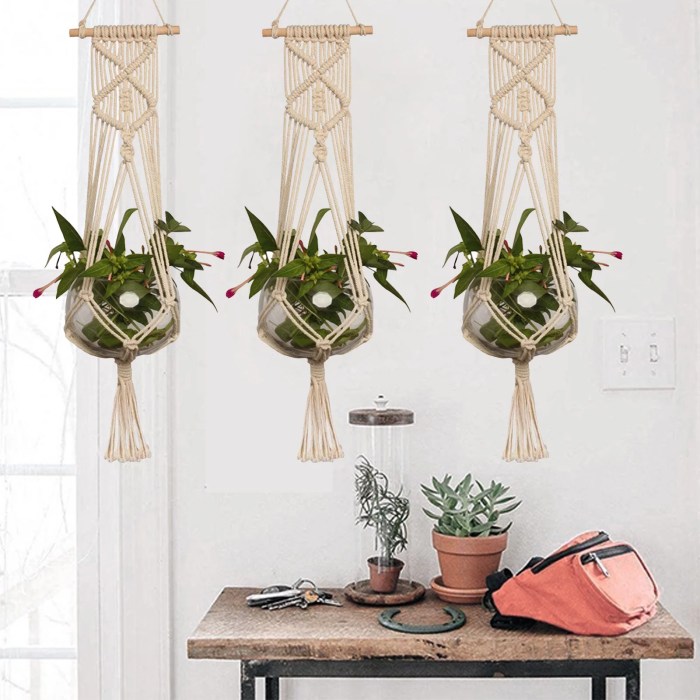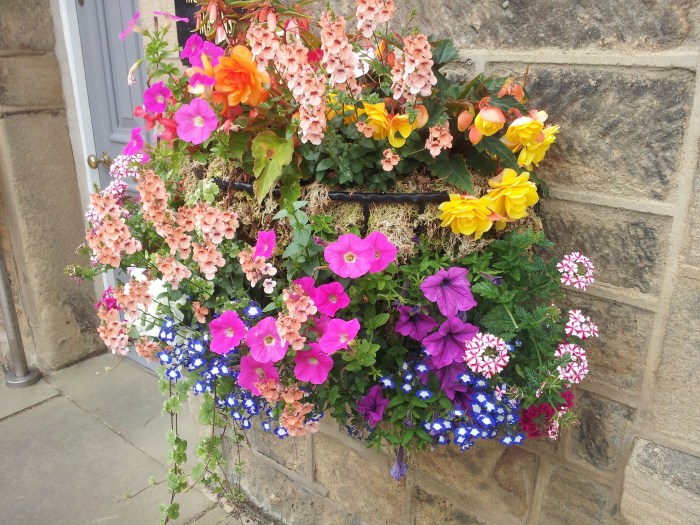Hanging basket flowers indoors bring a touch of nature and elegance to any room. Whether you’re looking to add a splash of color, create a vertical garden, or simply enhance your home decor, hanging baskets offer endless possibilities.
From selecting the perfect plants to designing and maintaining your hanging baskets, this comprehensive guide provides all the information you need to create stunning indoor displays that will thrive for years to come.
Suitable Indoor Hanging Basket Plants

Hanging baskets are a great way to add greenery and color to your indoor space. But not all plants are suitable for hanging baskets. When choosing plants for hanging baskets, it is important to consider factors such as light requirements, growth habits, and maintenance needs.
Some of the best plants for hanging baskets indoors include:
- Pothos: Pothos is a low-maintenance plant that is tolerant of a wide range of light conditions. It has trailing vines that can grow up to 10 feet long, making it a great choice for hanging baskets.
- Spider plant: Spider plants are another low-maintenance plant that is easy to care for. They have long, arching leaves that produce baby plants, or “spiderettes,” that can be used to propagate new plants.
- Ferns: Ferns are a great choice for hanging baskets in humid environments. They come in a variety of shapes and sizes, so you can find one that will fit your space.
- Trailing succulents: Trailing succulents are a great way to add a touch of greenery to your hanging baskets. They are drought-tolerant and require very little care.
- Herbs: Herbs are a great way to add flavor and fragrance to your indoor space. They can be grown in hanging baskets, but they will need to be watered more frequently than other plants.
Hanging Basket Design and Maintenance

Hanging baskets add a touch of elegance and greenery to any indoor space. Choosing the right design, planting technique, and maintenance routine is crucial for thriving indoor hanging baskets.
Hanging Basket Designs
- Materials:Hanging baskets come in various materials, including wicker, metal, plastic, and ceramic. Choose materials that complement your decor and provide adequate drainage.
- Shapes:Baskets come in round, square, oval, and rectangular shapes. Consider the shape that best fits your space and plant selection.
- Sizes:Sizes range from small (6-8 inches) to large (12-18 inches). Select a size that accommodates your plants’ root systems and the available space.
Planting, Watering, and Fertilizing
Proper planting techniques ensure healthy root development. Line the basket with a moisture-retentive liner and fill it with a well-draining potting mix. Space plants appropriately and water thoroughly after planting.
Hanging basket flowers can add a touch of greenery and color to any indoor space. When choosing flowers for hanging baskets, it’s important to select varieties that are well-suited to indoor conditions. Some of the best indoor hanging plants include ferns, ivy, pothos, and spider plants.
These plants are all relatively easy to care for and can tolerate low light conditions. They also have attractive foliage that will add interest to any room. For more information on great indoor hanging plants, visit great indoor hanging plants .
Watering frequency depends on the plant species and environmental conditions. Allow the soil to dry slightly between waterings and avoid overwatering. Fertilize hanging baskets every 2-3 weeks during the growing season using a balanced liquid fertilizer.
Pest and Disease Management
Hanging baskets can be susceptible to pests and diseases. Regular inspection is essential for early detection. Treat infestations promptly with insecticidal soap or horticultural oil. Preventative measures include using sterile potting mix, ensuring proper drainage, and avoiding overcrowding.
Creating a Vertical Garden with Hanging Baskets

Vertical gardening with hanging baskets is a space-saving technique that allows for the cultivation of plants in a vertical arrangement. By utilizing hanging baskets, gardeners can create a lush and visually appealing display that maximizes space and adds a touch of greenery to any indoor environment.Arranging
and spacing hanging baskets effectively is crucial to create a visually appealing and space-efficient vertical garden. Baskets should be hung at varying heights and distances to create a sense of depth and dimension. Consider the size and shape of the plants when choosing hanging baskets, ensuring there is sufficient space for growth and airflow.
Vertical Garden Designs Using Hanging Baskets
There are numerous vertical garden designs that can be created using hanging baskets. Here are a few examples:
-
-*Staggered Hanging Baskets
Baskets are hung at varying heights, creating a cascading effect. This design is suitable for trailing plants or those with long stems.
-*Vertical Wall of Baskets
Baskets are mounted vertically on a wall, forming a lush green tapestry. This design is ideal for small spaces or areas with limited floor space.
Hanging basket flowers can add a touch of elegance and charm to any indoor space. However, not all plants thrive in low-light conditions. For those looking for easy indoor hanging plants that can tolerate low light, there are several options available.
Here is a comprehensive guide to some of the best low-light hanging plants for indoor spaces, providing detailed information on their care and maintenance. With the right choice of plants, hanging basket flowers can create a beautiful and vibrant indoor oasis, even in areas with limited natural light.
-*Hanging Basket Trellis
A trellis is attached to the ceiling, and hanging baskets are suspended from it. This design provides support for climbing plants and creates a dramatic vertical display.
Hanging Baskets for Different Rooms: Hanging Basket Flowers Indoors

Incorporating hanging baskets into indoor spaces offers a versatile way to add greenery and enhance the aesthetics of different rooms. The type of hanging basket and plant selection should be tailored to the specific room’s environment, considering factors such as light availability, humidity, and temperature.
Living Room
Living rooms typically have ample natural light, making them suitable for a wide range of hanging plants. Choose baskets that complement the room’s decor, such as macrame hangers for a bohemian touch or metallic baskets for a modern look. Thriving plants for living rooms include:
- Pothos (Epipremnum aureum): A low-maintenance vine that tolerates low light conditions.
- Spider Plant (Chlorophytum comosum): Produces long, trailing stems with spiderette plantlets.
- Snake Plant (Sansevieria trifasciata): A succulent that purifies the air and tolerates neglect.
Bedroom, Hanging basket flowers indoors
Bedrooms require plants that can thrive in lower light conditions and contribute to a relaxing atmosphere. Opt for hanging baskets made of natural materials, such as wicker or jute. Suitable plants for bedrooms include:
- Peace Lily (Spathiphyllum wallisii): A flowering plant that purifies the air and prefers indirect light.
- ZZ Plant (Zamioculcas zamiifolia): A low-maintenance plant that tolerates low light and infrequent watering.
- Chinese Evergreen (Aglaonema): A foliage plant with variegated leaves that can tolerate low light.
Kitchen
Kitchens are often warm and humid, providing an ideal environment for plants that thrive in these conditions. Choose hanging baskets that can withstand moisture, such as ceramic or metal baskets. Recommended plants for kitchens include:
- Spider Plant (Chlorophytum comosum): Purifies the air and is easy to care for.
- Herbs (e.g., basil, parsley, mint): Can be grown in hanging baskets for easy access while cooking.
- Pothos (Epipremnum aureum): Tolerates low light and can help purify the air.
Bathroom
Bathrooms are typically humid and may have limited natural light. Choose hanging baskets that are resistant to moisture and consider plants that can thrive in these conditions. Suitable plants for bathrooms include:
- Boston Fern (Nephrolepis exaltata): A lush fern that prefers high humidity.
- Air Plant (Tillandsia): An epiphytic plant that absorbs moisture from the air, making it ideal for bathrooms.
- Snake Plant (Sansevieria trifasciata): Tolerates low light and infrequent watering, making it a low-maintenance option.
Seasonal Hanging Basket Displays

Hanging baskets offer a versatile way to add a touch of greenery and color to your indoor space. By selecting the right plants and providing proper care, you can create stunning displays that will bring joy throughout the year.
Seasonal hanging baskets allow you to enjoy the beauty of different plants as the seasons change. By choosing plants that are suited to the specific conditions of each season, you can create displays that are both visually appealing and thriving.
Suitable Plant Combinations for Different Seasons
| Season | Suitable Plants |
|---|---|
| Spring | Pansies, violas, lobelia, alyssum, and petunias |
| Summer | Geraniums, impatiens, begonias, lantana, and marigolds |
| Fall | Mums, asters, ornamental peppers, pansies, and violas |
| Winter | Poinsettias, cyclamen, hellebores, and paperwhites |
Seasonal Maintenance Tips for Hanging Baskets
To ensure the health and longevity of your hanging baskets, it is important to provide proper care throughout the year. This includes:
- Pruning: Regularly trim dead or damaged leaves and stems to promote new growth and prevent disease.
- Repotting: As plants grow, they may need to be repotted into larger containers to provide more space for roots.
- Protection from Extreme Weather Conditions: Protect hanging baskets from extreme heat, cold, and wind by moving them indoors or providing shade.
Festive Hanging Basket Displays for Holidays and Special Occasions
Hanging baskets can also be used to create festive displays for holidays and special occasions. By incorporating seasonal plants and decorations, you can create unique and eye-catching arrangements that will add a touch of cheer to your home.
For example, you could create a spring basket with pastel-colored flowers and Easter eggs, a summer basket with bright blooms and patriotic bunting, a fall basket with autumn leaves and pumpkins, or a winter basket with poinsettias and holiday ornaments.
Hanging basket flowers can add a touch of nature to any indoor space. But if you’re looking for a more modern way to display your plants, consider using geometric indoor wall planters. These planters are available in a variety of shapes and sizes, so you can find the perfect one to fit your décor.
They’re also easy to install, so you can get your plants up and off the floor in no time. And because they’re made from durable materials, they’ll last for years to come. So if you’re looking for a way to add some style to your indoor space, consider using geometric indoor wall planters.
You can find a variety of options online at hangingplantsindoor.com . Once you have your planters, you can start filling them with your favorite hanging basket flowers. With a little care and attention, your plants will thrive in their new home.
Outcome Summary

Hanging basket flowers indoors are not just a decorative element; they can also improve air quality, reduce stress, and boost your mood. So, embrace the beauty and benefits of nature by incorporating hanging baskets into your indoor living spaces and enjoy the year-round joy they bring.
FAQ Compilation
What are the best plants for hanging baskets indoors?
Some popular choices include ferns, ivy, pothos, spider plants, and succulents.
How often should I water my hanging baskets?
Water when the soil feels slightly dry to the touch, typically once or twice a week.
How can I create a vertical garden with hanging baskets?
Arrange baskets at different heights and stagger them to create a visually appealing and space-efficient display.